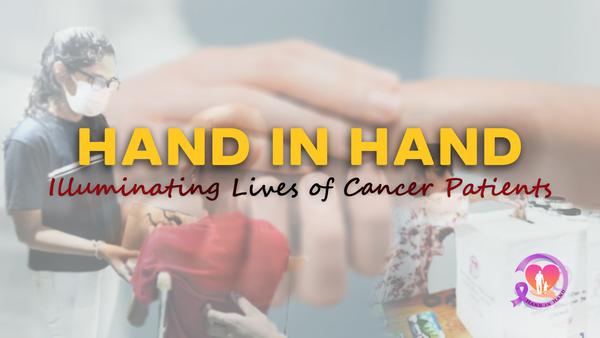Let's fight against Cancer: Types of Cancer - Leukemia
Do you know?
Cancer can develop anywhere in the human body. Leukemia can be identified as another serious disease that affects people regardless of age. Leukemia is a cancer of the blood and bone marrow. Bone marrow is the soft, spongy tissue in the center cavity of all bones. Hundreds of billions of new blood cells are produced in the bone marrow each day, providing your body with a constant supply of fresh, healthy cells.
In simple terms, Leukemia is defined as the uncontrolled growth of abnormal white blood cells. These abnormal cells then spill into the bloodstream. Unlike other cancers, leukemia generally doesn’t form into a tumor that can be seen in imaging tests, such as X-rays.
How did Leukemia get its name?
In fact, the term leukemia comes from the Greek words for white “leukos” and blood "haima”. An excess number of white blood cells are seen when looking at blood through a microscope and the actual appearance of the blood is lighter to the naked eye.
What is the first sign of leukemia?
Leukemia symptoms develop slowly. Generally, Leukemia begins with symptoms such as night sweats, fatigue, and fever. It is important to seek medical advice if fever symptoms persist longer than usual.
Other early symptoms of leukemia include:
1)Fever of unknown origin
2)Swollen lymph nodes (lumps along the neck, armpits, groins)
3)Blood stains on the skin
4)Bleeding from the gums, nose and urethra
5)Frequent infections
6)Easy bruising or heavy bleeding
7)Bone and joint pain
8)Difficulty breathing
9)Loss of appetite
10)Weight loss
Most often, leukemia is a cancer of the white blood cells, but some leukemias start in other blood cell types. There are several types of leukemia:
Acute Lymphocytic Leukemia (ALL)
"Acute" means that the leukemia can progress quickly and, if left untreated, can be fatal within few months. "Lymphocytic" means that it develops from early (immature) forms of lymphocytes, a type of white blood cell. The risk for developing ALL is highest in children younger than 5 years of age and adults in over 50 years of age. Overall, about 4 of every 10 cases of ALL are in adults. The average person’s lifetime risk of getting ALL is about 1 in 1,000. Also, most cases of ALL occur in children, but most deaths from ALL occur in adults.
Acute Myeloid Leukemia (AML)
It starts in the bone marrow, but most often it quickly moves into the blood, as well. It can sometimes spread to other parts of the body including the lymph nodes, liver, spleen, central nervous system (brain and spinal cord), and testicles. AML is the most common form of leukemia in adults. However, overall AML is relatively rare, accounting for only about 1% of all cancers.
Chronic Lymphocytic Leukemia (CLL)
This is the most common leukemia in adults. It's a type of cancer that starts in cells that become certain white blood cells (called lymphocytes) in the bone marrow. CLL mainly affects older adults and extremely rare in children.
Chronic myeloid leukemia (CML)
It is a type of chronic disorder in which the myeloid cells grow in the blood. Also, this type of leukemia mainly affects adults and is rarely seen in children. That is about 15% of leukemias in adults are CML.
Chronic Myelomonocytic Leukemia (CMML)
This starts in blood-forming cells in the bone marrow and invades the blood. This disease is rare in young people. Almost 9 of 10 of cases are diagnosed in people 60 and older. CMML occurs more often in men than in women.
Leukemia is the most common cancer in children and teens, accounting for almost 1 out of 3 cancers. Most childhood leukemias are acute lymphocytic leukemia (ALL). Most of the remaining cases are acute myeloid leukemia (AML). CLL and CML are rare in children. But fortunately, the survival rate is higher for younger people.
What causes leukemia?
A genetic predisposition, extensive exposure to artificial ionizing radiation, Persons taking long-term medications for other types of cancer (e.g. Azathioprine, Etoposide), tobacco use, use of certain hair dyes are some of them.
Can leukemia be cured?
Acute leukemia can often be cured. Chronic leukemia can be controlled with therapy.
There are various medical approaches to the treatment of leukemia. Treatment usually depends on the type of leukemia, the patient's age and health status, and whether the leukemia has spread to other organs. The goal of cancer treatment is to eliminate cancer, prevent recurrence and increasing the survival rate.
According to the National Cancer Institute (USA), the percentage of life expectancy by age group is as follows:
Patients younger than 44 years have high chances of life expectancy. However, patients aged 55-84 years have less chance of survival and aged 75-84 years of patients have very little chance of survival.
Leukemia awareness ribbon color: Orange
Leukemia awareness month: September
ඔබ දන්නවාද?
ලියුකේමියාව කාන්තාවන්ට වඩා පිරිමින් අතර බහුලව දක්නට ලැබේ. ඇත්ත වශයෙන්ම, මෙම පිළිකාව වැළඳීමේ අවදානම වයස සමඟ වැඩි වේ.
“ලියුකේමියාව බොහෝ විට 55 ට වැඩි වැඩිහිටියන් තුළ දක්නට ලැබේ, නමුත් එය 15 ට අඩු දරුවන් තුළ ද බහුලව දක්නට ලැබෙන පිළිකාවකි”
-ජාතික පිළිකා ආයතනය - ඇමරිකා එක්සත් ජනපදය-
පිළිකා මිනිස් සිරුරේ ඕනෑම තැනක වර්ධනය විය හැකිය. වයස් භේදයකින් තොරව ගොදුරු විය හැකි තවත් බරපතල රෝගයක් ලෙස ලියුකේමියාව හඳුනාගත හැක. ලියුකේමියාව යනු රුධිරයේ හා අස්ථි ඇටමිදුළුවල පිළිකාවකි. අස්ථි ඇටමිදුළුව යනු සියළුම අස්ථිවල මධ්ය කුහරයෙහි ඇති මෘදු, ස්පොන්ජි පටක වේ. සෑම දිනකම අස්ථි ඇටමිදුළුවල බිලියන සිය ගණනක් නව රුධිර සෛල නිපදවන අතර ඔබේ ශරීරයට නිරන්තරයෙන් නැවුම් සෞඛ්ය සම්පන්න සෛල ලබා දේ.
සරලව කිවහොත්, ලියුකේමියාව අසාමාන්ය සුදු රුධිරාණු වල පාලනයකින් තොරව වර්ධනය වීමක් ලෙස අර්ථ දැක්වේ. මෙම අසාමාන්ය සෛල පසුව රුධිරයට ගලා යයි. අනෙකුත් පිළිකා මෙන් නොව, ලියුකේමියාව සාමාන්යයෙන් එක්ස් කිරණ වැනි රූප පරීක්ෂණ වලදී දැකිය හැකි ගෙඩියක් බවට පත් නොවේ.
ලියුකේමියාවට එහි නම ලැබුණේ කෙසේද?
ඇත්ත වශයෙන්ම, ලියුකේමියාව යන වචනය පැමිණ ඇත්තේ සුදු “ලියුකොස්” සහ රුධිර “හයිමා” යන ග්රීක වචන වලිනි. අන්වීක්ෂයකින් රුධිරය දෙස බලන විට සුදු රුධිරාණු අතිරික්තයක් දක්නට ලැබෙන අතර රුධිරයේ සැබෑ පෙනුම පියවි ඇසට වඩා සැහැල්ලු ය.
ලියුකේමියා රෝගයේ පළමු රෝග ලක්ෂණ මොනවාද?
ලියුකේමියා රෝග ලක්ෂණ සෙමින් වර්ධනය වේ. සාමාන්යයෙන් ලියුකේමියාව ආරම්භ වන්නේ රාත්රී දහඩිය, තෙහෙට්ටුව සහ උණ වැනි රෝග ලක්ෂණ වලිනි. උණ රෝග ලක්ෂණ වෙනදාට වඩා දිගු කාලයක් පවතින්නේ නම් වෛද්ය උපදෙස් ලබා ගැනීම වැදගත්ය.
ලියුකේමියා රෝගයේ මුල් රෝග ලක්ෂණ අතර:
නොදන්නා සම්භවයක් ඇති උණ
ඉදිමුණු වසා ගැටිති (බෙල්ල දිගේ ගැටිති, කකුල්, ඉඟටිය)
සමේ රුධිර පැල්ලම් ඇතිවීම
විදුරුමස්, නාසය සහ මුත්රා මාර්ගයෙන් ලේ ගැලීම
නිතර ආසාදන
පහසු තැලීම් හෝ අධික රුධිර වහනයක්
අස්ථි හා සන්ධි වේදනාව
හුස්ම ගැනීමේ අපහසුතාව
ආහාර රුචිය නැතිවීම
බර අඩුවීම
බොහෝ විට, ලියුකේමියාව යනු සුදු රුධිරාණු වල පිළිකාවක් වන නමුත් සමහර ලියුකේමියාව වෙනත් රුධිර සෛල වර්ග වලින් ආරම්භ වේ. ලියුකේමියාව වර්ග කිහිපයක් තිබේ.
උග්ර ලිම්ෆොසයිටික් ලියුකේමියාව (ALL)
“උග්ර” යන්නෙන් අදහස් කරන්නේ ලියුකේමියාව ඉක්මනින් වර්ධනය විය හැකි අතර ප්රතිකාර නොකළහොත් මාස කිහිපයක් ඇතුළත මාරාන්තික විය හැකි බවයි. “ලිම්ෆොසයිටික්” යන්නෙන් අදහස් කරන්නේ එය සුදු රුධිරාණු වර්ගයක් වන ලිම්ෆොසයිට් වල මුල් (නොමේරූ) ආකාර වලින් වර්ධනය වන බවයි. වයස අවුරුදු 5 ට අඩු ළමුන් සහ වයස අවුරුදු 50 ට වැඩි වැඩිහිටියන් තුළ ALL වර්ධනය වීමේ අවදානම වැඩිය. සමස්තයක් වශයෙන්, ALL රෝගීන් 10 න් 4 ක්ම වැඩිහිටියන් තුළ වේ.මෙම රෝගයට ගොදුරු වීම සාමාන්ය පුද්ගලයාගේ ජීවිත අවදානමෙන් 1000 න් 1 ක් පමණ වේ.ALL හි බොහෝ අවස්ථා ළමුන් තුළ දක්නට ලැබුන ද, බොහෝ මරණ සිදුවන්නේ වැඩිහිටියන්ගෙනි.
උග්ර මයිලෝයිඩ් ලියුකේමියාව (AML)
මෙය ඇට මිදුළු වලින් ආරම්භ වන නමුත් බොහෝ විට එය ඉක්මනින් රුධිරයට ගමන් කරයි. එය සමහර විට වසා ගැටිති, අක්මාව, ප්ලීහාව, මධ්යම ස්නායු පද්ධතිය (මොළය හා කොඳු ඇට පෙළ) සහ වෘෂණ කෝෂ ඇතුළු ශරීරයේ අනෙකුත් කොටස් වලට පැතිර යා හැකිය. AML යනු වැඩිහිටියන් තුළ බහුලව දක්නට ලැබෙන ලියුකේමියාවකි. කෙසේ වෙතත්, සමස්තයක් වශයෙන් AML තරමක් දුර්ලභ වන අතර එය පිළිකා වලින් 1% ක් පමණ වේ.
නිදන්ගත ලිම්ෆොසයිටික් ලියුකේමියාව (CLL)
මෙය වැඩිහිටියන් අතර බහුලව දක්නට ලැබෙන ලියුකේමියාවයි. එය අස්ථි ඇටමිදුළුවල ඇති සුදු රුධිරාණු (ලිම්ෆොසයිට් ලෙස හැඳින්වෙන) බවට පත්වන සෛල වලින් ආරම්භ වන පිළිකා වර්ගයකි.CLL ප්රධාන වශයෙන් ඉතා මහලු පුද්ගලයන්ට බලපාන අතර ළමුන් තුළ අතිශයින් දුර්ලභ ය.
නිදන්ගත මයිලෝයිඩ් ලියුකේමියාව (CML)
එය රුධිරයේ මයිලෝයිඩ් සෛල වර්ධනය වන නිදන්ගත ආබාධයකි. මෙම වර්ගයේ ලියුකේමියාව ප්රධාන වශයෙන් වැඩිහිටියන්ට බලපාන අතර ළමුන් තුළ දක්නට ලැබෙන්නේ කලාතුරකිනි. එනම් වැඩිහිටි ලියුකේමියා රෝගීන්ගේන් 15% ක් පමණ CML රෝගීන් වේ.
නිදන්ගත මයිලෝමොනොසයිටික් ලියුකේමියාව (CMML)
මෙය ඇට මිදුළු වල රුධිරය සාදන සෛල වලින් ආරම්භ වී රුධිරය ආක්රමණය කරයි. මෙම රෝගය යෞවනයන් තුළ දුර්ලභ ය. රෝගීන් 10 න් 9 ක්ම 60 සහ ඊට වැඩි පුද්ගලයින්න් ලෙස හඳුනාගෙන ඇත. CMML කාන්තාවන්ට වඩා පිරිමින් තුළ බොහෝ විට සිදු වේ.
ලියුකේමියාව ළමුන් හා යෞවනයන් අතර බහුලව දක්නට ලැබෙන පිළිකාවක් වන අතර පිළිකා 3 න් 1 කට ආසන්න ප්රමාණයක් එයට හේතු වේ. බොහෝ ළමා ලියුකේමියා උග්ර ලිම්ෆොසයිටික් ලියුකේමියාව (ALL) වේ. ඉතිරිව ඇති රෝගීන්ගෙන් බොහොමයක් උග්ර මයිලෝයිඩ් ලියුකේමියාව (AML) වේ. CLL සහ CML ළමුන් තුළ දුර්ලභ ය. නමුත් වාසනාවකට මෙන්, යෞවනයන්ගේ පැවැත්මේ අනුපාතය ඉහළ මට්ටමක පවතී.
ලියුකේමියාව ඇතිවීමට හේතු මොනවාද?
ජානමය නැඹුරුතාවයන්, කෘතිම අයනීකරණ විකිරණවලට නිරාවරණය වීම, වෙනත් වර්ගවල පිළිකා සඳහා දිගු කාලීනව ඹෟෂධ ගන්නා පුද්ගලයින් (උදා: අසාතියෝප්රීන්, බුසල්ෆාන්, එටොපොසයිඩ්), දුම්කොළ භාවිතය, ඇතැම් හිසකෙස් සායම් භාවිතය ඒවායින් සමහරක් වේ.
ලියුකේමියාව සුව කළ හැකිද?
උග්ර ලියුකේමියාව බොහෝ විට සුව කළ හැකිය. චිකිත්සාව සමඟ නිදන්ගත ලියුකේමියාව පාලනය කළ හැකිය. ලියුකේමියාව සඳහා විවිධ වෛද්ය ප්රවේශයන් ඇත. ප්රතිකාර සාමාන්යයෙන් රඳා පවතින්නේ ලියුකේමියාව, රෝගියාගේ වයස සහ සෞඛ්ය තත්වය මෙන්ම ලියුකේමියාව වෙනත් අවයව වලටද පැතිරී තිබේද යන්න මතය. පිළිකා ප්රතිකාරයේ පරමාර්ථය වන්නේ පිළිකා තුරන් කිරීම, නැවත පැමිණීම වැළැක්වීම සහ පැවැත්මේ වේගය වැඩි කිරීමයි.
ජාතික පිළිකා ආයතනයට (ඇමරිකා එක්සත් ජනපදය) අනුව, වයස් කාණ්ඩ අනුව ආයු අපේක්ෂා ප්රතිශතය පහත පරිදි වේ.
අවුරුදු 44 ට අඩු රෝගීන්ට ආයු අපේක්ෂාව ඉහළ මට්ටමක පවතිී.
කෙසේ වෙතත්, වයස අවුරුදු 55-84 අතර රෝගීන්ගේ පැවැත්මට ඇති ඉඩකඩ අඩු වන අතර වයස අවුරුදු 75-84 අතර රෝගීන්ගේ ආයු අපේක්ෂාව ඉතා අල්පය.
ලියුකේමියා පිලිබද දැනුවත් කිරීමේ වර්ණය: තැඹිලි
ලියුකේමියාව පිලිබද දැනුවත් කිරීමේ මාසය: සැප්තැම්බර්
Check out our other blogs on cancer;
1) What is cancer: https://blog.rotaractmora.org/what-is-cancer/
2) What causes cancer: http://blog.rotaractmora.org/causes-of-cancer/
3) Childhood cancer: http://blog.rotaractmora.org/fight-against-cancer/
4) Leukemia: https://blog.rotaractmora.org/hih-cancer-leukemia/
5) Brain cancer: https://blog.rotaractmora.org/brain-cancer/
6) Lung cancer: https://blog.rotaractmora.org/lung-cancer/
7) Breast cancer: https://blog.rotaractmora.org/breast-cancer/
8) Skin cancer: http://blog.rotaractmora.org/skin-cancer/
9) Oral cancer: https://blog.rotaractmora.org/oral-cancer/
10) Thyroid cancer: https://blog.rotaractmora.org/thyroid-cancer-2/
11) Movie review- The fault in our stars: https://blog.rotaractmora.org/movie-review-the-fault-in-our-stars/
12) Cervical cancer: http://blog.rotaractmora.org/cervical-cancer/
13) Colorectal cancer: http://blog.rotaractmora.org/colorectal-cancer/
14) Movie review: My life without me: http://blog.rotaractmora.org/moviereviewmylifewithoutme/
15) Cancer health policy of WHO: http://blog.rotaractmora.org/health-policy-of-who/



